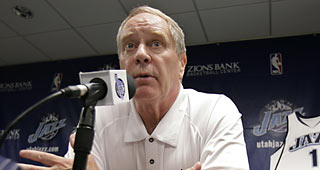With a week left in the regular season, the final playoff spot in the Western Conference is down to three teams: the Phoenix Suns, Houston Rockets and Utah Jazz. But while both the Suns and Rockets are firmly stuck on the mediocrity treadmill, not bad enough to rebuild and not good enough to contend, the Jazz have pulled off the high-wire act of committing to a full rebuild without tanking.
Houston GM Daryl Morey has become a cult figure in the NBA blogosphere, but it’s Utah GM Kevin O’Connor who has been running rings around most of the league. He should be the NBA’s Executive of the Year, as the Jazz will be reaping the fruits of his decisions for years to come.
The only way for a small-market team to build a championship contender is through the draft, which is why tanking has become increasingly popular. But because O’Connor sold high when he had an unhappy superstar, he was able to get two high lottery picks without needing to blow up the rest of the team.
The Jazz acquired two high-upside 6’10+ players (Enes Kanter and Derrick Favors) without the losing teams typically need to do so, which has given them the luxury of bringing both young big men along slowly. Utah has two parallel cores in place: a veteran group led by Al Jefferson, Paul Millsap and Devin Harris and a nucleus of four under-22 lottery picks.
Utah also has the rights to the Golden State Warriors 2012 first-round pick if it falls outside of the top 7; they could get a playoff berth and a lottery pick out of the 2011-12 season while the Warriors get neither.
However, having lottery picks is only half the battle. A GM still needs to be able to identify good young talent that “fits” well together over the long haul. O’Connor has been masterful, selecting players at premium positions whose skill sets don’t replicate each other.
When he was shopping Deron Williams, he ignored flashy perimeter talent and focused on finding an athletic young big man who can protect the rim. Favors has slipped under the radar in his first two seasons, but he’s a 6’10 245 athlete with a 7’4 wingspan and a 35’ max vertical capable of anchoring a championship-caliber defense. Per-36 minutes, the 20-year-old is averaging 14.7 points, 11.1 rebounds and 1.6 blocks on 49% shooting.
In the 2011 Draft, rather than taking a point guard like Brandon Knight, he opted for Kanter, a 6’11, 260 big man with an excellent feel for scoring out of the low post as well as a developing mid-range jumper (he is shooting 65.6% from the free-throw line this season). Per-36 minutes, the 19-year-old is averaging 12.2 points and 11.6 rebounds on 49% shooting.
While the rest of the NBA is getting smaller, Utah will have a 6’10+ athlete who can patrol the paint and a skilled 6’11+ player who can punish teams offensively. It’s the same basic formula the Dallas Mavericks used to stun their more high-profile opponents in the 2011 playoffs.
Just as importantly, O’Connor’s selections give him a lot more flexibility going forward. There will always be good guards available, which is why Utah took a center, power forward and small forward first, as it’s much harder to find even replacement-level players at those positions.
Hayward, their 6’8, 210 small forward, will never be a star, but he has the skill-set and athleticism to be a solid two-way starter. Per-36 minutes, the 22-year-old is averaging 14.1, 4.2 rebounds and 3.7 assists on 45% shooting.
Burks, their 6’6, 200 shooting guard, may not be a front-line starter, as he’s neither a great jump shooter (shooting 29% from three) nor playmaker (averaging 2.2 assists on 2.0 turnovers). However, he’s a good athlete who can get to the rim and create his own shot (averaging 16.0 points per 36 minutes while taking 40% of his shots in the paint), and he could become a Sixth Man of the Year candidate as a bench scorer.
And with a frontcourt of the future already in place, O’Connor will have the luxury of picking through one of the deepest drafts in recent memory for perimeter help.
His first priority should be at point guard, as Favors and Kanter need someone who can run a team, find them on the break and get them shots in the half-court. Kendall Marshall (UNC) would make a lot of sense, as Utah could hide his defensive shortcomings while his jaw-dropping passing ability (9.8 assists on 2.8 turnovers this year) would be extremely valuable on a roster full of finishers.
Meanwhile, if Golden State’s rather embarrassing attempt to keep their pick comes up short, O’Connor will be able to round out his starting five with a future star at shooting guard. Bradley Beal (Florida) will probably be off the board, but Terrence Ross (Washington), Jeremy Lamb (UConn) and Dion Waiters (Syracuse) should still be available, and all three have All-Star caliber athleticism, shooting and shot-creating ability.
Two years ago, Utah was a capped-out veteran team with a frustrated star eyeing free agency. Now, thanks to O’Connor’s shrewd long-term planning, they have one of the NBA’s most promising young core all while staying in playoff contention. Even if the Jazz end up falling behind the Rockets or the Suns, they are in a far superior position going forward.

Jonathan Tjarks wrote on the NBA for RealGM from 2011-2016 before joining The Ringer.
Follow @JonathanTjarks on Twitter.


